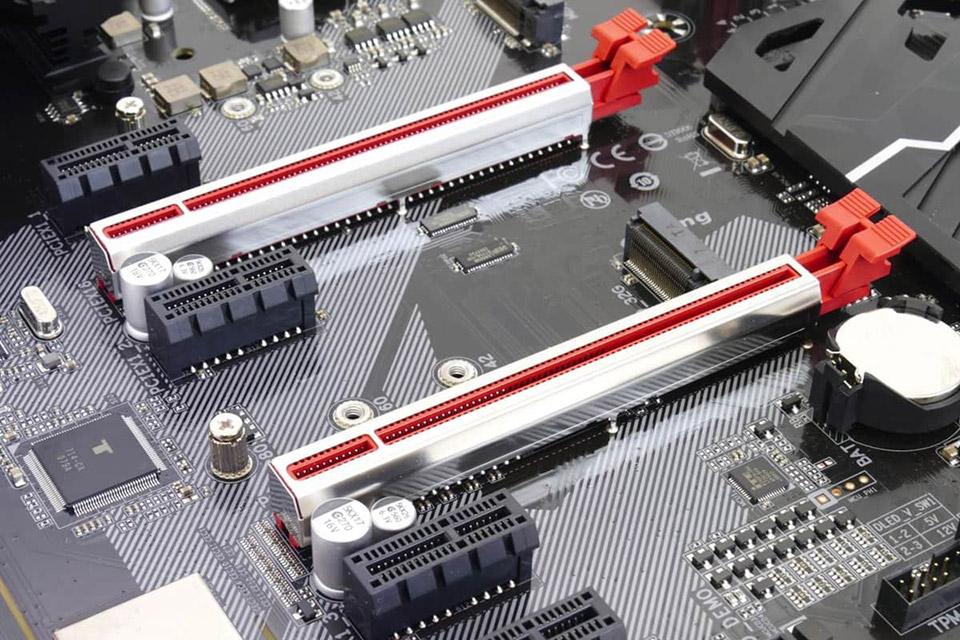PCI Connector

PCI stands for Peripheral Component Interconnect, which is a standard bus protocol and interface used for connecting peripheral devices to a computer motherboard. It is the most common method for connecting add-on controller cards and other hardware devices to a computer system.
The PCI standard defines the electrical and physical characteristics of the interface, including the size, length, and number of contact points on the connector. The most common PCI connector type is known as PCI-Express (PCIe), which has largely replaced the older PCI and PCI-X standards.
PCIe connectors come in different form factors, including PCIe x1, PCIe x4, PCIe x8, and PCIe x16, which represent the number of lanes or data pathways available for data transfer. The larger the number of lanes, the higher the potential bandwidth and performance.
The length and size of PCIe connectors may vary depending on the form factor and design of the specific motherboard or expansion card. The connector itself consists of a plastic or metal housing with a series of electrical contacts or pins that align with the corresponding slots on the motherboard.
PCIe slots on the motherboard provide the physical connection points for the expansion cards. These slots are typically identified by their length, such as PCIe x1, PCIe x16, etc., indicating the number of lanes and the maximum bandwidth supported.
By utilizing PCIe connectors and slots, various types of add-on cards can be connected to a computer system, such as graphics cards, network adapters, sound cards, storage controllers, and other expansion cards. The PCIe interface offers high-speed data transfer rates and low latency, making it suitable for demanding applications and high-performance devices.
It's worth noting that the specific capabilities and compatibility of PCI connectors may vary depending on the generation (e.g., PCIe 1.0, PCIe 2.0, PCIe 3.0, PCIe 4.0) and the specific motherboard or device. Therefore, it's important to consider the supported specifications and requirements of the devices being connected when choosing PCI connectors and expansion cards. Different generations of PCI, such as PCIe 1.0, PCIe 2.0, PCIe 3.0, and PCIe 4.0, offer varying levels of bandwidth and performance. Each generation introduces improvements in data transfer rates, signal integrity, and features. Therefore, it's essential to ensure compatibility between the PCI generation supported by the motherboard and the PCI generation required by the expansion card.
For example, if you have a PCIe 3.0 motherboard, it can support PCIe 3.0 expansion cards as well as backward compatibility with PCIe 2.0 and PCIe 1.0 cards. However, the performance and capabilities may be limited to the lowest common denominator, meaning that a PCIe 3.0 card may only operate at PCIe 2.0 or PCIe 1.0 speeds if inserted into a compatible slot.
Additionally, specific devices may have requirements for the number of lanes (x1, x4, x8, x16) they need to achieve their full potential performance. Therefore, it's essential to consider the number of lanes available in the PCIe slots on the motherboard and match them with the requirements of the expansion card to ensure optimal performance.
For example, a longer PCIe x16 card may not physically fit into a smaller PCIe x1 slot.
When selecting PCI connectors and expansion cards, it's important to consider factors such as the supported PCI generation, number of lanes, and physical compatibility to ensure proper functionality and optimal performance. Consulting the documentation or specifications provided by the motherboard and the expansion card manufacturers can help determine compatibility and make informed decisions.
The PCI standard defines the electrical and physical characteristics of the interface, including the size, length, and number of contact points on the connector. The most common PCI connector type is known as PCI-Express (PCIe), which has largely replaced the older PCI and PCI-X standards.
PCIe connectors come in different form factors, including PCIe x1, PCIe x4, PCIe x8, and PCIe x16, which represent the number of lanes or data pathways available for data transfer. The larger the number of lanes, the higher the potential bandwidth and performance.
The length and size of PCIe connectors may vary depending on the form factor and design of the specific motherboard or expansion card. The connector itself consists of a plastic or metal housing with a series of electrical contacts or pins that align with the corresponding slots on the motherboard.
PCIe slots on the motherboard provide the physical connection points for the expansion cards. These slots are typically identified by their length, such as PCIe x1, PCIe x16, etc., indicating the number of lanes and the maximum bandwidth supported.
By utilizing PCIe connectors and slots, various types of add-on cards can be connected to a computer system, such as graphics cards, network adapters, sound cards, storage controllers, and other expansion cards. The PCIe interface offers high-speed data transfer rates and low latency, making it suitable for demanding applications and high-performance devices.
It's worth noting that the specific capabilities and compatibility of PCI connectors may vary depending on the generation (e.g., PCIe 1.0, PCIe 2.0, PCIe 3.0, PCIe 4.0) and the specific motherboard or device. Therefore, it's important to consider the supported specifications and requirements of the devices being connected when choosing PCI connectors and expansion cards. Different generations of PCI, such as PCIe 1.0, PCIe 2.0, PCIe 3.0, and PCIe 4.0, offer varying levels of bandwidth and performance. Each generation introduces improvements in data transfer rates, signal integrity, and features. Therefore, it's essential to ensure compatibility between the PCI generation supported by the motherboard and the PCI generation required by the expansion card.
For example, if you have a PCIe 3.0 motherboard, it can support PCIe 3.0 expansion cards as well as backward compatibility with PCIe 2.0 and PCIe 1.0 cards. However, the performance and capabilities may be limited to the lowest common denominator, meaning that a PCIe 3.0 card may only operate at PCIe 2.0 or PCIe 1.0 speeds if inserted into a compatible slot.
Additionally, specific devices may have requirements for the number of lanes (x1, x4, x8, x16) they need to achieve their full potential performance. Therefore, it's essential to consider the number of lanes available in the PCIe slots on the motherboard and match them with the requirements of the expansion card to ensure optimal performance.
For example, a longer PCIe x16 card may not physically fit into a smaller PCIe x1 slot.
When selecting PCI connectors and expansion cards, it's important to consider factors such as the supported PCI generation, number of lanes, and physical compatibility to ensure proper functionality and optimal performance. Consulting the documentation or specifications provided by the motherboard and the expansion card manufacturers can help determine compatibility and make informed decisions.





